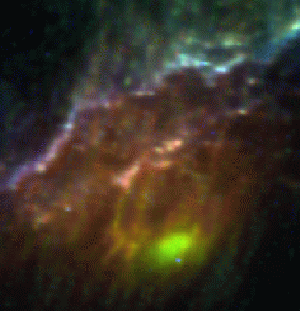Menkib (Xi Persei)

Xi Persei can be seen together with the California Nebula, white and reddish from low-left to up-right. The bow shock in front of the runaway star is the green patch. Xi Per itself can be seen as a faint blue spot on the lower edge of the bow shock. Image: IRAS.
Menkib (Xi Persei) is one of the very few naked-eye O stars and one of the hottest and most massive stars visible without the aid of a telescope. The fact that it is only the twelfth brightest star in the constellation Perseus is due to its great distance and also because about half of its light is absorbed by dust in the plane of the Milky Way. Menkib is probably responsible for illuminating the California Nebula (NGC 1499). Its name, meaning "collarbone," refers to a larger Arabic constellation of which Atik is the "shoulder." It is slightly unstable, changing its brightness by about 5%, and also blowing a powerful stellar wind by which it sheds about a millionth of a solar mass per year. Though the star's status is uncertain – somewhere between giant and supergiant – it has almost certainly stopped core hydrogen fusion, and may even be fusing helium, already having lost some 10% of its original mass. Still only a few million years old, it will explode sometime in the next million yr or so. Like Naos, it is also one of the sky's few runaway stars. For reasons still uncertain, it is traveling at high speed away from its birthplace in the Perseus OB2 Association (which also contains it sister star Atik), the acceleration caused either by a close encounter with another star or by the explosion of a now-dead and even more massive companion. Menkib has a present companion, a much smaller star, about which nothing is known, in a 7-day orbit.
| visual magnitude | 3.98 |
| absolute magnitude | -4.70 |
| spectral type | O7Iae |
| surface temperature | 37,000 K |
| luminosity | 330,000 Lsun |
| mass | 40 Msun |
| distance | 1,770 light-years |
| position | RA 03h 58m 57.9s; Dec +35° 47' 28" |


